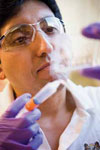A Productive Partnership
A collaboration between Harvard University and UNM creates many new opportunities
From elementary school students in Albuquerque to leading researchers in Boston, the Partnership for Research and Education in Biomaterials (PREM) is improving education and inspiring high impact research in biomaterials science and engineering.
Funded by NSF, the PREM is designed to help under-represented groups become more aware of and involved in materials science and to stimulate general interest in science and technology. The University of New Mexico, Albuquerque Public Schools, and Harvard University are partners in the program.
 The five-year, $2.5 million PREM grant started in 2006 and is a cornerstone of UNM's Center for Biomedical Engineering (CBME), which fosters interdisciplinary research, including biomaterials science and engineering. Gabriel López, director of CBME and professor of chemical and nuclear engineering, led the way to establishing the PREM. "I thought it was a natural fit. Harvard is one of the premier organizations doing biomaterials work. Even though we don't have a traditional materials science program, UNM is recognized around the country as being strong in both materials science and biological research," says López. The UNM team includes co-principal investigators Heather Canavan, Elizabeth Hedberg-Dirk, and Dimiter Petsev, all assistant professors of chemical and nuclear engineering, as well as Julia Fulghum, vice president for research.
The five-year, $2.5 million PREM grant started in 2006 and is a cornerstone of UNM's Center for Biomedical Engineering (CBME), which fosters interdisciplinary research, including biomaterials science and engineering. Gabriel López, director of CBME and professor of chemical and nuclear engineering, led the way to establishing the PREM. "I thought it was a natural fit. Harvard is one of the premier organizations doing biomaterials work. Even though we don't have a traditional materials science program, UNM is recognized around the country as being strong in both materials science and biological research," says López. The UNM team includes co-principal investigators Heather Canavan, Elizabeth Hedberg-Dirk, and Dimiter Petsev, all assistant professors of chemical and nuclear engineering, as well as Julia Fulghum, vice president for research.
Comprehensive Education and Research
One of the goals of the PREM grant is an active, multi-faceted biomaterials education and research program that encourages students to strive for the highest level in their careers. Students from UNM and Harvard participate in visiting scholar exchanges, collaborations with networks of research professionals, professional development resources, and community outreach. PREM research has resulted in the development of a number of new materials and materials systems with applications in the diagnosis and treatment of infectious disease, cardiovascular disease, and cancer.
The PREM helped Sergio Mendez, (Ph.D., CHNE, '04) a post-doctoral researcher in the Department of Chemical and Nuclear Engineering, achieve his goal of becoming a professor. As part of the PREM program to groom minority postdoctoral candidates into the professoriate, UNM offered Mendez a full-time position that split his time between teaching and conducting research.
 While he gained experience teaching undergraduate courses, Mendez worked with a team from Harvard to engineer a biosensor that can detect different viruses. The sensor, similar to a pregnancy test, uses a small paper test strip that is coated to detect specific viruses. "This device is low-cost, fast, and could be handed out in a developing country for simple screenings," he says. Mendez also received professional interview skills training at Harvard. His comprehensive PREM experience helped him achieve his goal: this fall he will start teaching at California State University, Long Beach.
While he gained experience teaching undergraduate courses, Mendez worked with a team from Harvard to engineer a biosensor that can detect different viruses. The sensor, similar to a pregnancy test, uses a small paper test strip that is coated to detect specific viruses. "This device is low-cost, fast, and could be handed out in a developing country for simple screenings," he says. Mendez also received professional interview skills training at Harvard. His comprehensive PREM experience helped him achieve his goal: this fall he will start teaching at California State University, Long Beach.
Like Mendez, Jamie Reed, who is working on her doctorate in chemical engineering, is advancing her education and research with help from the PREM. Her research focuses on developing microfluidic devices to make micro-sized gel beads that can be used as mini platforms for growing individual cells. Reed worked with a post-doctoral fellow and David Weitz, Mallinckrodt Professor of Physics and of Applied Physics at Harvard. She spent a month in Weit's lab learning to create the tiny devices that create a stream of solid gel beads about 25 microns in diameter.
 When Reed adjusts the temperature, the beads swell, causing the cells to pop off the surface intact. "Many proteins extend out of the cell and into the extracellular matrix, where the cell makes contact with other cells and the tissue culture substrate. These proteins tell the cell whether to proliferate or go into cell death, so keeping these proteins intact is important. These beads allow us to do that," explains Reed. Current methods of pulling the cell off the matrix destroy these critical proteins. Reed is optimizing her device at UNM before researchers at UNM’s Cancer Research Facility use the microgels to advance their study of cancer cells.
When Reed adjusts the temperature, the beads swell, causing the cells to pop off the surface intact. "Many proteins extend out of the cell and into the extracellular matrix, where the cell makes contact with other cells and the tissue culture substrate. These proteins tell the cell whether to proliferate or go into cell death, so keeping these proteins intact is important. These beads allow us to do that," explains Reed. Current methods of pulling the cell off the matrix destroy these critical proteins. Reed is optimizing her device at UNM before researchers at UNM’s Cancer Research Facility use the microgels to advance their study of cancer cells.
 Kevin Cushing, a graduate student working on his doctorate in Biomedical Sciences at the UNM School of Medicine, is also participating in PREM-supported research. He’s working with engineers to create a prostate cancer diagnostic tool that uses microparticles. The particles' intrinsic properties allow them to bind with specific biological elements in samples of blood or urine. Once they bind with the chosen biological particle, they can be separated from other unwanted biological elements and analyzed. "This ability should give our system greater measurement sensitivity and accuracy than other bioassay formats," says Cushing.
Kevin Cushing, a graduate student working on his doctorate in Biomedical Sciences at the UNM School of Medicine, is also participating in PREM-supported research. He’s working with engineers to create a prostate cancer diagnostic tool that uses microparticles. The particles' intrinsic properties allow them to bind with specific biological elements in samples of blood or urine. Once they bind with the chosen biological particle, they can be separated from other unwanted biological elements and analyzed. "This ability should give our system greater measurement sensitivity and accuracy than other bioassay formats," says Cushing.
Cushing's particles are demonstrating good results. Now he’s refining the process to make it more sensitive to lower PSA concentrations in the biological sample. "The PREM has given me the opportunity to work with great engineers who are focused on performing research to benefit society," he says.
Effective Outreach
UNM students participating in PREM research help with outreach programs that introduce elementary, middle, and high schools students to bioengineering and materials science. They give presentations in English and Spanish, coordinate an in-class project, and discuss pathways to careers in materials science. Each age group works with a different kit presented to the class by a university student or faculty member. High school students learn about medical implants and middle school students study polymers. Elementary school students study prosthetics by creating a finger with materials from a kit containing paperclips, straws, rubber bands, and more.
Reed presented the kits in the schools, including her alma mater, Albuquerque High School, and says the experience is valuable for her and the students. "I like going back and telling these kids—especially the girls—about engineering and encouraging them to understand that there are many opportunities for them in bioengineering and related fields. PREM outreach gave me valuable leadership experience, and it was gratifying to hear the enthusiastic response from the students as well as the teachers."
Reed says she's gained much more than research experience from the PREM. "I've been given so many opportunities that made me competitive." Reed is parlaying that competitive edge into other important achievements. She recently attended the Lindau Nobel Laureate Meetings, a globally recognized forum that brings together Nobel Laureates with young researchers for a week-long information exchange.
Along with K-12 classroom activities, PREM outreach includes teacher workshops, student mentoring and research internship opportunities, and special events. Harvard professors recently came to UNM and gave a presentation to approximately 200 grade school students on the material properties of chocolate, with live experiments, demonstrations, and chocolate tastings.
Growing Collaborations
Collaboration between UNM and Harvard faculty and students is a mainstay of the PREM. Kathryn Hollar, director of educational programs for the School of Engineering and Applied Sciences at Harvard, works with López to coordinate PREM events and partnerships. "Sharing ideas across the two institutions has been great," comments Hollar. "When people with different expertise get together, intersections are created that develop into new products and research tools."
López is encouraged by the advances created by the PREM and notes that the collaborations now extend beyond Harvard. "We've formed new alliances in bioengineering research and education across the state, including with New Mexico Tech, New Mexico Highlands University, San Juan College, and New Mexico State University." These collaborations are furthering the PREM goals of building a pipeline of students interested in biomaterials science and training New Mexicans for critically needed jobs in biomedical engineering.
The future of this multi-faceted biomaterials education and research program looks bright:: a recent NSF programmatic review indicates that the PREM is transforming biomedical engineering research and education in New Mexico.
